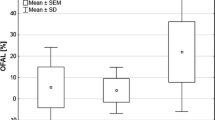Abstract
Objective: The role of human papillomavirus (HPV) in the development of cervical carcinoma has been clearly established but other factors could be involved in cervical tumorigenesis such as loss of heterozygosity (LOH) and microsatellite instability (MI). The aim of the present study was to investigate the genetic instability in cervical carcinoma tissues and provide evidence for discovering new tumor suppressor genes and screening diagnostic molecular marker of cervical carcinoma. Methods: Fifty primary cervical carcinoma samples from high-incidence area were analyzed by PCR for HPV16 infection, LOH and microsatellite instability. Results: HPV16 was detected in 88% of the cases. Sixty-six percent of total cases showed LOH with no more than 3 different loci per case. The highest frequency of the allelic loss was found in D18S474 (18q21, 40.5%). MI was detected in 4 cases (8%) only. Conclusion: Different percentages of LOH on specific chromosomal regions were found and MI was very infrequent in cervical carcinoma. The putative suppressor gene(s) could be located on specific chromosome regions such as 18q, and genetic instability could be involved in cervical tumorigenesis.
Similar content being viewed by others
References
Harald Zur Hausen. Papillomavivus infections—a major cause of human cancers. Biochinica et Biophysica Acta 1996; 1288: F55-F78.
Rodriguez JA, Barros F, Carracedo A, et al. Low incidence of microsatellite instability in patients with cervical carcinomas. Diagn Mol Pathol 1998; 7: 276.
Larson AA, Kern S, Sommers RL, et al. Analysis of replication error (RER+) phenotypes in cervical carcinoma. Cancer Res 1996; 56: 1426.
Matthews CP, Shera KA, McDougall JK, et al. Genomic changes and HPV type in cervical carcinoma. Proc Soc Exp Biol Med 2000; 223: 316.
Jones DL, Thompson DA, Munger K. Destabilization of the RB tumor suppressor protein and stabilization of p53 contribute to HPV type 16 E7-induced apoptosis. Virology 1997; 239: 97.
Daniel B, Rangarajan A, Mukherjee G, et al. The link between integration and expression of human papillomavirus type 16 genmes and cellular changes in the evolution of cervical intraepithelial neoplastic lesions. J Gen Virol 1997; 78: 1095.
Song S, Liem A, Miller JA, et al. Human papillomavirus types 16 E6 and E7 contribute differently to carcinogenesis. Virology 2000; 267: 141.
Lazo PA. The molecular genetics of cervical carcinoma. Br J Cancer 1999; 80: 2008.
Mullokandov MR, Kholodilov NG, Atkin NB, et al. Genomic alterations in cervical carcinoma: losses of chromosome heterozygosity and human papillomavirus tumor status. Cancer Res 1996; 56: 197.
Mitra AA, Murty VVVS, Rong G, et al. Allelotype analysis of cervical carcinoma. Cancer Res 1994; 54: 4481.
Sambrook J, Fritsch EF, Maniatis T. Molecular Cloning: A laboratory Manual. 2nd ed. Cold Spring Harbor, NY: Cold Spring Harbor Laboratory 1989.
Mironov NM, Aguelon A, Potapova G, et al. Alterations of (CA)n DNA repeats and tumor suppressor genes in human gastric cancer. Cancer Res 1994; 54: 41.
Arzimanoglou II, Gilbert F, Barber HRK. Microsatellite instability in human solid tumors. Cancer 1998; 82: 1808.
Lothe RA, Peltomaki P, Meling GI, et al. Genomic instability in colorectal cancer: relationship to clinicopathological variables and family history. Cancer Res 1993; 53: 5849.
Wooster R, Cleton-Jansen AM, Collins N, et al. Instability of short tandem repeats (microsatellites) in human cancers. Nat Genet 1994; 6: 152.
Reuter S, Bartelmann M, Vogt M, et al. APM-1, a novel human gene, identified by aberrant co-transcription with papillomavirus oncogene in a Cervical carcinoma cell line, encodes a BTB/POZ- Zinc finger protein with growth inhibitory activity. EMBO J 1998; 17: 215.
Rodriguez E, Sreekantaiah C, Chaganti RS. Genetic changes in epithelial solid neoplasia. Cancer Res 1994; 54: 3398.
Fearon ER, Peirceall WE. The deleted in colorectal cancer (DCC) gene: a candidate tumor suppressor gene encoding a cell surface protein with similarity to the neural cell adhesion molecules. Cancer Surv 1995; 24: 3.
Klingelhutz AJ, Smith PP, Garret LR, et al. Aleration of the DCC tumor-suppressor gene in tumorigenic HPV-18 immortalized human karatinocytes transformed by nitrosomethylurea. Oncogene 1993; 8: 95.
Wistuba II, Montellano FD, Milchgrub S, et al. Deletions of chromosome 3p are frequent and early events in the pathogenesis of uterine cervical carcinoma. Cancer Res 1997; 57: 3154.
Wong YF, Chung TK, Cheung TH, et al. Frequent loss of heterozygosity of chromosome 3 short arm detected by PCR-based microsatellite polymorphisms in cervical squamous cell carcinoma. Cancer Lett 1997; 115: 161.
Fouret PJ, Dabit D, Mergui JL, et al. Loss of heterozygosity on the short arm of chromosome 3 in cervical intra-epithelial neoplasia without concomitant cervical carcinoma. Pathol Biol 1998; 66: 306.
Krul EJ, Kersemaekers AM, Zomerdi Jk-Nooyen YA, et al. Different profiles of allelic losses in cervical carcinoma cases in Surinam and the Netherlands. Cancer 1999; 86: 997.
Bethwaite PB, Koreth J, Herrington CS, et al. Loss of heterozygosity occurs at the D11s 29 locus on chromosome 11q23 in invasive cervical carcinoma. Br J Cancer 1995; 71: 814.
O’sullivan MJ, Rader JS, Gerhard DS, et al. Loss of heterozygosity at 11q23.3 in vasculoinvasive and metastatic squamous cell carcinoma of the cervix. Hum Pathol 2001; 32: 475.
Chung TK, Ip TY, Hampton GM, et al. Microsatellite instability incervical carcinoma. Eur J Obstet Gynecol 2001; 94: 121.
French D, Cermele C, Vecchione A, et al. HPV infection and microsatellite instability in squamous lesions of the uterine cervix. Anticancer Res 2000; 20: 3417.
Ottini L, Falchetti M, D’Amico C, et al. Mutations at coding mononucleotide repeats in gastric cancer with the microsatellite mutator phenotype. Oncogene 1998; 16: 2767.
Author information
Authors and Affiliations
Corresponding author
Additional information
Foundation item: This work was supported by the National Natural Science Foundation of China (No. 301710420).
Biography: Zhao Min(1972–), male, doctor of medicine, lecturer, Wuhan University Medical College, majors in virology and Tumor molecular biology.
Rights and permissions
About this article
Cite this article
Zhao, M., Wu, Xx., Qiu, Xp. et al. Genetic instability in cervical carcinoma. Chin. J. Cancer Res. 14, 246–250 (2002). https://doi.org/10.1007/s11670-002-0054-z
Received:
Accepted:
Issue Date:
DOI: https://doi.org/10.1007/s11670-002-0054-z




